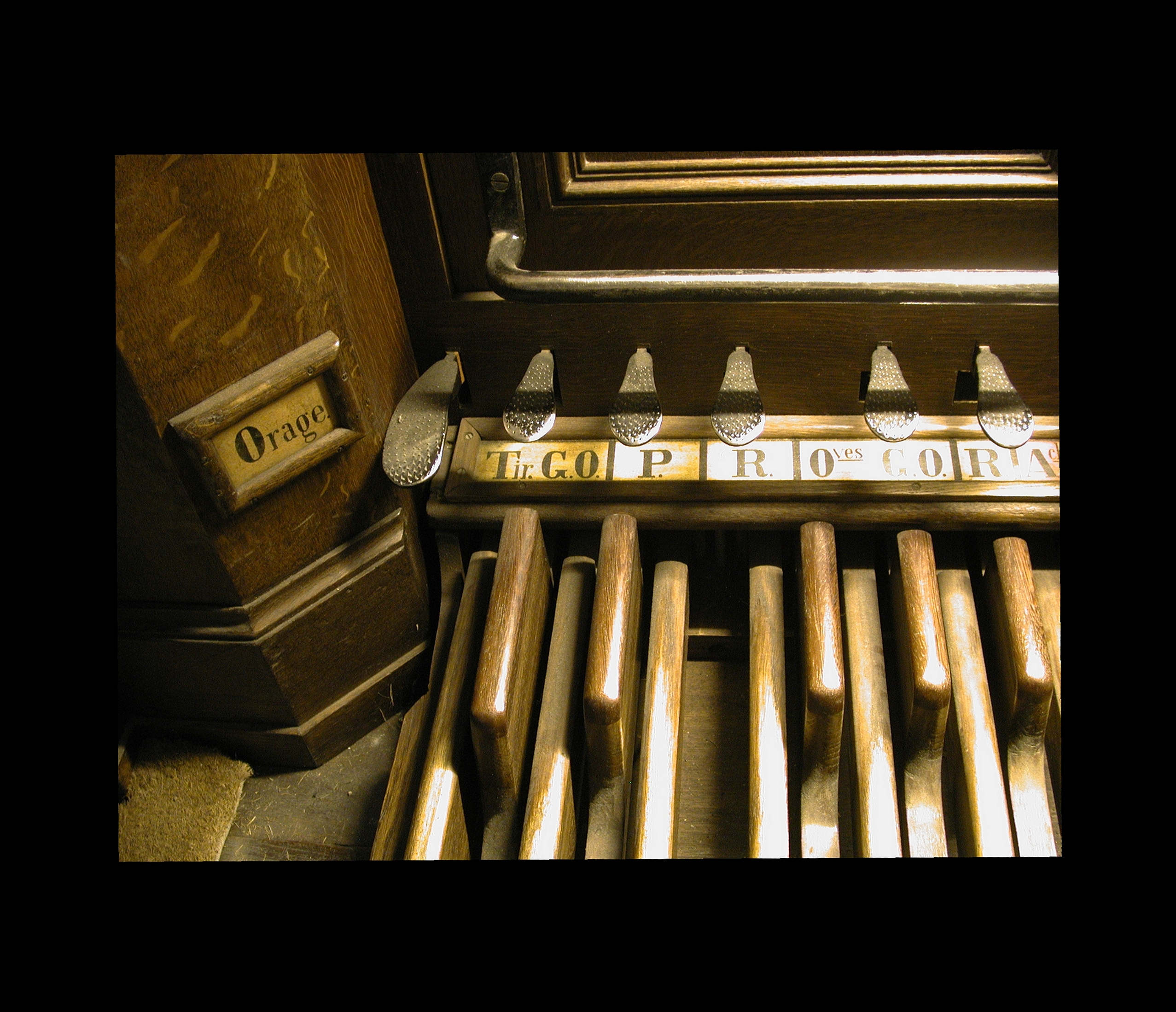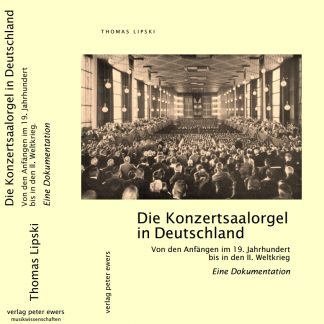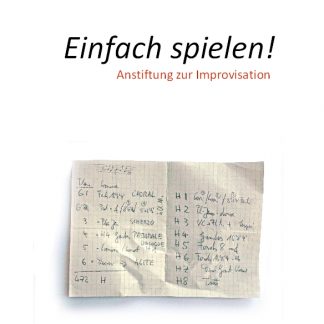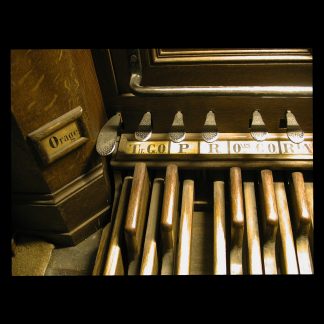Beschreibung
The Symphonic Organ Sampleslibrary is very simple to use. There are 5 GigaSampler instruments in this library. These are not individual stops but carefully selected combinations of stops chosen by Peter Ewers himself during the reording sessions. These are some of the most commonly unsed combinations for this organ and are also used on Peter’s latest CD played on this organ.
Cathedral Reverb built in!
All 5 instruments feature the actual reverb of La madeleine. You will be amazed at how wonderful this sounds! Studio reverb units simply can’t recreate this kind of ambiance. These reverb tails last serveral seconds and build up as you play, just like a real cathedral pipe organ does. The ambience defaults to full volume but you can adjust the volume with the Mod-Wheel. (We like to leave the hall reverb all the way up ourselves!) You can even lower the reverb level while you play and on the final chord, bring it up so that you get the full decay when you release the notes.
Instruments
I. Symphonic Organ – Tutti
(All stops pulled out)
II. Symphonic Organ – Tutti Pedal
(All Stops pulled out pedal notes)
III. Symphonic Organ – Fonds 16’8’4′
(16, 8 and 4 foot pipe combinations)
IV. Symphopnic Organ – Fonds 8′
(8 foot pipe combinations)
V. Symphonic Organ – Pedal 32’16‘
(32 and 16 foot pipe combination pedal notes)
Besprechungen
Peter Ewers Symphonic Organs
I would just like to say how fantastic Peter Ewers Symphonic Organ Samples are. I am new to this digital sampling business but I must say how incredible it is to be able to play such wonderful sounds via controller keyboards and a PC.
I did agonise about purchasing GiGaStudio and the Symphonic Organs disk, as I was not sure about my PC set-up. However I was pleasantly surprised to find out that my Sound Blaster Live card performs without any noticeable latency when I am playing and the quality of the sound is superb. I did initially have some \“pops\“ presumable because of my set-up, although I know not what type my hard disk is it is. However the Windows and hard disk set-up advise and the 2.01 upgrade seems to have resolved this.
My hope now is that Peter Ewers will produce more organ instruments with similar quality and natural reverb as this first disc and Nemesys will continue with the development of GigaStudio and the endless wave technology.
Any interested pianist or organist who wants to play such a remarkable Cathedral Organ, at home, should not hesitate to try it out. I am sure you will get hooked as I have.
Many thanks to all involved and please keep up the good work.
JohnEB
http://northernsounds.com/forum/showthread.php/7815-Peter-Ewers-Symphonic-Organs
Okey Ausgabe 34, 2000:
Aber auch eine Pfeifenorgel bekommt ihre ganz besonderen Qualitäten. Zu hören besonders mit einer Sample – CD, aufgenommen an der großen symphonischen Cavaillé – Coll Orgel der Pariser Kirche Madeleine durch den renommierten Organisten Peter Ewers. Der geniale französische Orgelbauer und Begründer der symphonischen Orgel Aristide Cavaillé-Coll (1811-1899) baute hier ein großes Instrument, an dem so berühmte Namen wie Camille Saint-Saëns, Théodore Dubois, u.a. wirkten. – Diesen Klang kann ich besonders beurteilen, weil ich selbst schon 7 Orgel-CDs mit dem Gesamtwerk von Théodore Dubois an diesem Instrument eingespielt habe. – Aufgenommen wurden diese Samples in der natürlichen und mit einem reichen Hall versehenen Akustik der Madeleine. Allein dieses macht den jeder Computerorgel überlegen, diesen Hall kann man einfach nicht künstlich erzeugen, aber durch die größeren Längen der Samples ist auch das Klangbild viel natürlicher. Ich fühlte mich beim Spiel dieses Samples wirklich wie in der Madeleine, nachts um 23 Uhr, nur das Fehlen des Lärmes der neuen METRO unter der Kirche störte diese Illusion, der uns bei den Aufnahmen manchmal zu schaffen machte. Allerdings muß man auch sagen, die lediglich 5 Samples bieten nur den kleinsten Teil der klanglichen Substanz dieser wunderbaren Orgel. Gesampelt wurden das Tutti (alle Register gezogen), das Tutti des pedales, die Fonds 16‘, 8‘, 4‘, weiterhin die Fonds 8‘ und die sanfteren 32‘ und 16‘ Stimmen des Pedales. Dafür dürfte der Preis einer solchen CD mit knapp 600,- DM auch so manchen Liebhaber unter Orgelfreunden abschrecken. In jedem Falle wird diese Serie erst dann so richtig interessant, wenn mehrere CDs mit den Soloregistern und anderen typischen Romantikregistrierungen (Voix céleste, Voix humaine, Clarinette, Fonds douce, Cornet etc.) der Cavaillé-Coll Orgel in der Madeleine vorliegen und vielleicht zu einem etwas moderaterem Preis gebündelt werden. Trotzdem: High End Qualität einer noch wenig beachteten Sparte bei Sampling CDs. Die CD liegt nur im eigenen Giga Sampling Format vor – Titel: Peter Ewers, Symphonic Organ Samples, Nemensys Soundware.





The Peter Ewers Symphonic Organ Samples
Bruce Richardson
The Peter Ewers Symphonic Organ Samples are yet another example of the incredible toolset GigaSampler brings to orchestral composers.
The Peter Ewers Symphonic Organ Samples library serves up three different perspectives on one of the most significant pipe organs in the world, the Grand Cavaille-Coll Organ at the Eglise de la Sainte Madeleine in Paris. This organ was at the forefront of the transition to the modern pipe organ. But it is no dinosaur. To this day, it is widely recognized as one of the finest instruments ever constructed.
Folks, take a moment and really consider this. We can have the authentic sound of a 150 year-old pipe organ come alive in our studios and in our performances. And if that weren’t enough, we get the sound of its build and decay into the cathedral itself.
This is realism with more than sonic significance. If you could set up a recording session in this very cathedral, and play your parts live on this very instrument, you might not come away with as good a recording as you can get with this library. And you would certainly not be able to revisit the instrument every time you got the urge. Think of this: if this organ were destroyed tomorrow, its sound would live on, thanks to this sample library. It’s big stuff in my book.
Pipe organs (actually all sustaining instruments) are difficult to sample. The sound changes infinitely over time. No matter how you loop a pipe organ note, you’ll notice the loss of vitality as it hits its repeating state. Yet, even with GigaSampler, how does one avoid looping? Notes can’t go on forever, even when you’re sampling into the gigabyte-plus library sizes we’re beginning to see.
On this library, we’re given LONG samples that have no loops. Eventually, they simply end. There are a few times when I ran out of „note“ on this instrument, but not many, and none at all in actual performance.
You will only find yourself running out of tone when you’re sitting in the studio playing around. You’ll find yourself holding out chords forever just to hear the beautiful and ever evolving sound. It’s addicting. You just want to hold it longer and turn the monitors up louder.
The cathedral reverb is a great trick. As you release a note, instead of a gate, you advance to the end of the sample–where the actual cathedral resonance begins. So, as you’re playing the instrument, you hear the tones building up more and more the longer you hold a note, and each note’s recorded tail as you release.
If you analyze the paradigm closely, you’ll realize that this isn’t exactly the way the acoustics work, but it is plenty close enough.
The illusion is amazing, and playing this instrument is a ball. Recording it is a treat as well. I have used it many times in some very public projects, and people never fail to comment on the beauty and power of the organ sounds. Trust me, you’ve never heard any electronically generated pipe organ sound that can match it.
So, What’s the Catch
In a recording environment, none. Some folks have commented on the cathedral reverb. You can turn the release samples off, and simply use outboard reverb, if the long reverb tails are creating problems with your mix.
You might also want to go sans reverb if you play the library in live performance. Suppose you’re playing in an actual cathedral with your trusty GigaRig. It’s a better idea to let the performance venue put its own resonance on the samples, and just add a bit of the cathedral resonance or outboard reverb if you need it. The sonic imprint of the original cathedral could be too distinctive to use in this context, and might actually compromise realism rather than enhance it.
I have spoken to organists who question the decision to provide only three „setups“ of stop combinations (and of course, two different pedal setups as well). The stated intention of the producers was to provide the most-often performed combinations. On this point, I tend to agree with the detractors. I would love to roll my own combinations of pipes. After all, I am NOT an organist, and I might come up with an amazing combo that’s far too outside the box for someone with a „purer“ perspective to consider.
Given that reservation, I will say that the choices Mr. Ewers made are good-sounding and useable. The tutti is huge and room filling, while maintaining that amazing transparency of sound that no other instrument can quite match. The two smaller combinations are sweeter in nature. The 16′,8′,4′ combo is well articulated and complex. The smallest-sounding 8′ combo is simply divine, a floating swirl of color. All awash with the release resonances, it sounds like the music they’d play in heaven. An amazing instrument all by itself, with uses that are not limited to traditional organ music. I’ve used it as a synth pad with fine result.
Some of the notes have extramusical sounds that are a result of noisy mechanisms in the organ itself. This is not the only sample set with this characteristic, but it certainly has a few great examples. My guess is that these are included because they are authentic and charming.
My perspective differs a bit. When you’re dinking around with the samples and just enjoying, these little quirks are indeed rather charming. On the other hand, when you’re battling a deadline at the eleventh hour, and one of those charming bellows-farts is making your woofers pop out of the basket, the charm fades. I would encourage instrument designers to bear this in mind, and let the timbres speak for themselves. There’s no need to force additional realism in the form of mechanical defect, since this will nearly always inconvenience the end user. Capture the „defect“ sample, catalog the sample to be sure…but when building the actual sampled instrument, avoid single notes that call too much attention to themselves. They come back to haunt.
That’s a rather lame criticism on my part, really more of a user wish, and at most an artistic difference of opinion. I can see why it would swing either way, depending on who makes the call. Peter Ewers Symphonic Organ Samples is a class act through and through, capable of transporting you to a seat at one of the most celebrated pipe organs in the world. Organists will want it just for the joy of playing it. Composers get an instrument of beauty and authenticity that would be impossible to afford on any but the highest production budgets. Another amazing tool, within the grasp of anyone that needs it.
Sounds on Sounds, Martin Walker
Peter Ewers‘ Symphonic Organ • • • •
(NEMESYS GIGASAMPLER CD-ROM)
Nearly all of us will have experienced the awe-inspiring acoustics of a cathedral at some time in our lives, and those lucky enough to hear a large pipe organ played well in such surroundings won’t forget the experience in a hurry. Most synth pipe-organ sounds fall sadly short by comparison, since they either rely on a simple looped waveform or a short sample. The real thing uses bellows and a series of pipes of different lengths, one for each note of each stop (equivalent to the drawbar on an electronic organ).
Each pipe takes a certain amount of time to ’speak‘, and has its own unique attack ‚chiff‘, but stops are normally used in combination in various amounts, resulting in multiple pipes sounding for each note. Unlike an electronic instrument, these are not phase-locked, which adds further depth and richness to the final sound. When you add in the wind-chest activity and bellows noises you gain a sound that is hard to match by simply mixing together a few short samples.
Peter Ewers has used the potential of the GigaSampler software to capture the magic of the world-famous organ of the Eglise de la Sainte Madeleine in Paris, inaugurated in 1846. Rather than providing recordings of single stops, he’s created five Giga instruments that use carefully selected combinations. Three are for keyboard use, with the normal range of five octaves, while the other two are normally played by the bass pedals, with a 32–note (2.5-octave) range. Like the real thing, there’s no velocity sensitivity.
Each note has been recorded unlooped and lasts for anything between thirty seconds and a full minute — more than enough to cope with any real performance. The simplest is Fonds 8′ — a selection of eight-foot pipe combinations with a rich but mellow sound — while Fonds 16′ 8′ 4′ reinforces this with further pipes an octave above and an octave below for more body, and Tutti is the magnificent and powerful sound of every stop pulled fully out. All three instruments have a range of C2-C7, while the two pedal instruments play over the range C2-G4, and incorporate the lower 32′ stops — Pedal 32′ 16′ and Tutti Pedal. Playing a C2 note incorporating a 32′ stop generates frequencies right down to 32Hz, so watch those monitors!
The masterstroke is that each pipe has been recorded close up and from much further away, to incorporate the actual ambience of Saint Madeleine cathedral. These distant recordings are triggered on note release, last for six or seven seconds (just like the real thing), and normally default to full volume. However, you can vary the hall ambience level using the mod wheel, between fully wet and fully dry. Although this isn’t exactly how reverb works, the results speak for themselves: the most realistic pipe organ I’ve ever heard emerges from the sampler. MIDI Controller 94 (effect depth) can also disable the ambience altogether if you want to use an outboard reverb.
Some may feel that there should be more combinations of stops, or ways of mixing several to taste, but I suspect that for the vast majority of users the choices made by professional organist Peter Ewers in this 480Mb collection cover the right area. If you want the true magnificence and power of a pipe organ in your music, it doesn’t get much better than this! Martin Walker